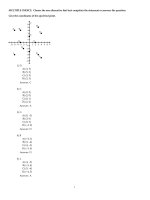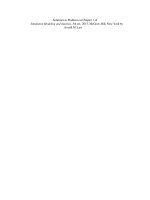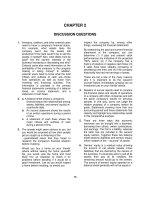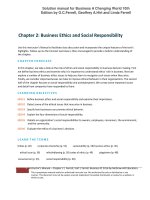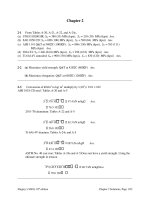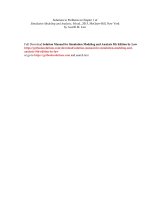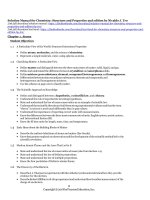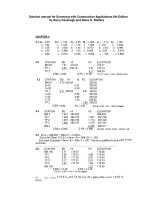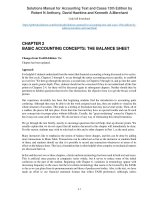Solution manual for accounting concepts and applications 10th edition by albrecht
Bạn đang xem bản rút gọn của tài liệu. Xem và tải ngay bản đầy đủ của tài liệu tại đây (385.35 KB, 36 trang )
Link full download:
/>
CHAPTER 2
DISCUSSION QUESTIONS
inspect the company by, among other things,
reviewing the financial statements.
1. Investors, creditors, and other external users
need to know a company's financial status.
For example, what assets does the company
own? Are the assets still productive? How
hard would it be to sell the assets, if
needed? Also, what debts must be paid? Are
the owners' interests in the business
increasing or decreasing and why? External
users also need information on the
profitability of the company. Is the company
making or losing money? In addition,
external users need to know what the total
inflows and outflows of cash are—those
from operations as well as those from
investing and financing activities. This
information is provided in the primary
financial statements consisting of a balance
sheet, an income statement, and a
statement of cash flows.
By researching the past and current financial
statements of the company, you can
determine (1) if past and present stock
performances are indicative of the projected
150% return; (2) if the company has a
history of positive or negative cash flows; (3)
if sales have been steadily increasing or
decreasing over time; and (4) if the company
historically has had net earnings or losses.
These are but a few of the many reasons
why it is important to do the research
yourself before immediately jumping into an
investment just on your friends' advice.
4. Readers of annual reports need to compare
the financial status and results of operations
of a company with other companies and with
the same company's results for previous
periods. In this way, users can judge the
relative progress of a company toward its
goals. Statements covering more than one
accounting period and those statements that
classify and highlight key relationships assist
in this comparative analysis.
2. a. A balance sheet shows a company's
financial status (the relationships among
assets, liabilities, and owners' equity) at
a particular date.
b. An income statement shows the results
of an entity's operations during a period
of time.
c. A statement of cash flows shows the
major inflows and outflows of cash
during a period of time.
5. There are three ways that economic
resources can be brought into a business:
borrowing from others, owner contributions,
and earnings. The first is a liability, whereas
the latter two are included in the owners'
equity section. Together these two balance
sheet sections (liabilities and owners' equity)
inform readers of the ―sources'' of assets.
3. The answer might seem obvious to you, but
you would be surprised at how often people
get so caught up in dreaming of the
―guaranteed‖ return that they forget to
research the company's financial situation
before investing.
6. Owners' equity is a residual value showing
the amount of net assets (assets minus
liabilities) that are claimed by the owners of
the business. If a business were to sell all its
assets, then pay all its creditors, the
remaining amount would go to the owners.
The amount of owners' equity reported on a
balance sheet generally will not be equal to
Would you buy a home on your friends'
advice without seeing the home yourself?
No, you would view the home and most likely
hire an inspector to check it for problems
before deciding if it would be a good
investment. Just as you would inspect a
home before investing, so should you
15
16
Chapter 2
the current worth of a business since the
assets generally are reported at their
historical costs, not at their current values.
The amount of owners' equity is represented
by all assets (after deducting liabilities), not
just cash.
operations is a key figure that should be
highlighted.
11.
When financial statements are prepared in
accordance
with
generally
accepted
accounting principles (GAAP), certain
guidelines or rules have been followed in
measuring and reporting the yearly financial
activities. In expressing an opinion, an
auditor attests and affirms that the
guidelines followed are commonly accepted
by the accounting profession. Thus, the
auditor's opinion gives assurance that the
results of operations have not been distorted
because a firm uses different or incorrect
accounting principles and procedures. The
auditor's opinion also gives some assurance
that management's financial statements
fairly represent what actually occurred during
the year. Without such assurances,
misleading
or
ill-prepared
financial
statements could cause substantial losses to
unwary investors.
12.
Auditors cannot assure that the financial
statements are accurate, because their
examination is not based on a test of every
item and every transaction. Time and fee
constraints require that an audit be based on
a sample of items. Auditors review a
sufficient sample of evidential material to
form a professional opinion, but accuracy is
still the responsibility of the preparer of the
statements—management. The auditor's
function is to express an opinion about the
financial statements.
13.
The four types of financial statement notes
typically included in an annual report are (1)
summary of significant accounting policies,
(2) additional information about summary
totals, (3) disclosure of information not
recognized,
and
(4)
supplementary
information.
14.
The importance of the basic accounting
concepts or assumptions is as follows:
7. The balance sheet has two main limitations.
First, assets are initially recorded at their
purchase cost and subsequent changes in
value may or may not be recorded on the
books. The second limitation is that some
important economic assets, called intangible
assets, are not reported at all, although they
may be the most valuable assets to the
company.
It is important to be aware of these
limitations when evaluating a company's
growth potential because the company may
be worth much more (or less) than its book
value shows.
8. Some people feel that the income statement
is more important than the balance sheet
because it shows the profitability of a
company. In turn, profitability relates to
future cash-generating ability, which is of
prime interest to most users of financial
reports. Others feel that the balance sheet is
more important than the income statement
because cash flow is eventually translated
into the asset and equity balances reported
on the balance sheet. Properly informed
people realize that all three primary financial
statements are equally important and
complementary.
9. By looking only at the net income or EPS
number, an investor might not see the
important relationships of various categories
on an income statement. For example,
revenues less operating expenses equals
operating income. If an unusual gain or loss
on some nonoperating item is added to or
subtracted from operating income, net
income and the EPS number may be
distorted and would not reflect the results of
normal operations for the period.
10.
Cash flows should be classified according to
operating, investing, and financing activities
in order to help investors and others see the
sources and uses of cash by major activity.
For example, if a company is not providing a
net cash inflow from operations and instead
has to borrow cash to keep the business
running, it may not stay in business long.
Thus, the amount of net cash provided from
a. The separate entity concept identifies
the particular organizational unit for
which accounting data are compiled.
The entity is the focal point for
accumulating,
measuring,
and
communicating accounting data.
b. Arm's-length transactions are those in
which the buyer and seller are rational
and
free
to
act
independently.
Accounting for and analyzing economic
Chapter 2
transactions enable the accountant to
measure the successes and failures of a
reporting entity. If transactions between
entities involve any favoritism or
irregularity, the data measured by the
accountant will lose validity; that is, the
data will not accurately measure the
success of the reporting entity.
c. The cost principle requires transactions
to be recorded at historical costs, the
amounts originally paid in an arm'slength transaction. This ensures that
accounting data are objective, since the
exchange price (historical cost) at the
date of the transaction is presumed to
reflect the fair market value of an item at
that date.
d. Monetary measurement provides a
quantitive
means
of
measuring
transactions and comparing the results
of operations for various reporting
entities.
17
e. The going concern assumption states
that, unless there is evidence to the
contrary, the entity will continue in
operation for the foreseeable future. If
the opposite assumption were made—
that the entity was about to go out of
business—accountants would record
liquidation values on the books of the
entity.
18
Chapter 2
PRACTICE EXERCISES
PE 2–1 (LO1)
Total Assets
Computation of total assets:
Cash ............................................................................
Accounts receivable ..................................................
Inventory .....................................................................
Equipment...................................................................
Total assets ................................................................
PE 2–2 (LO1)
$
800
1,000
3,500
10,000
$15,300
Total Liabilities
Computation of total liabilities:
Accounts payable .......................................................
Wages payable ...........................................................
Loan payable ..............................................................
Total liabilities ............................................................
PE 2–3 (LO1)
$
900
500
9,000
$10,400
Total Owners’ Equity
Computation of total owners’ equity:
Capital stock ...............................................................
Retained earnings ......................................................
Total owners’ equity...................................................
$1,500
3,400
$4,900
Refer to the solutions for PE 2–1, 2–2, and 2–3. To confirm the accuracy of the
solutions, we can verify assets are equal to liabilities plus owners’ equity:
Total assets ................................................................
$15,300
Total liabilities ............................................................
Total owners’ equity...................................................
Total liabilities and owners’ equity ...........................
$10,400
4,900
$15,300
PE 2–4 (LO1)
The Accounting Equation
Case A
$10,000 – $4,000 = $6,000 Owners’ equity
Case B
$8,000 – $3,500 = $4,500 Liabilities
Case C
$5,500 + $7,000 = $12,500 Assets
Case D
$13,000 – $15,000 = ($2,000) Owners’ equity
Note that in this case, total owners’ equity is negative because
liabilities are greater than assets.
19
Chapter 2
PE 2–5 (LO1)
Balance Sheet
Assets
Cash ............................................................................
Accounts receivable ..................................................
Inventory .....................................................................
Equipment...................................................................
Total assets ................................................................
$
800
1,000
3,500
10,000
$15,300
Liabilities
Accounts payable .......................................................
Wages payable ...........................................................
Loan payable ..............................................................
Total liabilities ............................................................
900
500
9,000
$10,400
Owners’ Equity
Capital stock ...............................................................
Retained earnings ......................................................
Total owners’ equity...................................................
Total liabilities and owners’ equity ...........................
$ 1,500
3,400
$ 4,900
$15,300
PE 2–6 (LO1)
$
Current Assets
Computation of total current assets:
Cash ............................................................................
Accounts receivable ..................................................
Inventory .....................................................................
Total current assets ...................................................
PE 2–7 (LO1)
$ 625
800
2,100
$3,525
Current Liabilities
Computation of total current liabilities:
Accounts payable .......................................................
Loan payable (due in 6 months)................................
Total current assets ...................................................
$700
250
$950
For simplicity, the entire $10,000 amount of the mortgage payable is assumed to
be a long-term liability. However, if monthly payments are to be made on the
mortgage during the next year, some part of the liability is current. This portion
might be labeled as ―current portion of mortgage payable.‖
20
Chapter 2
PE 2–8 (LO1)
1.
Book value of equity:
Case A
Case B
Case C
Case D
2.
Book Value and Market Value of Equity
Assets
$ 10,000
8,000
13,500
100,000
=
Liabilities
$ 4,000
7,000
5,500
150,000
Owners’ Equity
$ 6,000
1,000
8,000
(50,000)
+
Market value of equity:
Case A
Case B
Case C
Case D
Shares of Stock
Outstanding
1,000
500
300
1,000
Price per
Share
$15
10
20
7
=
Market
Value
$15,000
5,000
6,000
7,000
Cases A and B illustrate the normal case in which the accounting book value
understates the actual value of the company. In Case C, the market value is
actually less than the book value; this can occur when a company makes
unwise investment and operating decisions after the owners have invested
their money. Case D illustrates that a company can have positive market
value even when the book value of equity is negative. Surprisingly, about 5%
of publicly-traded U.S. companies have negative equity book values.
PE 2–9 (LO2)
Total Revenues
Computation of total revenues:
Sales ............................................................................
Consulting revenue ....................................................
Interest revenue .........................................................
Total revenues ............................................................
PE 2–10 (LO2)
$13,600
2,700
900
$17,200
Total Expenses
Computation of total expenses:
Cost of goods sold .....................................................
Advertising expense ..................................................
Total expenses ...........................................................
$10,200
2,150
$12,350
21
Chapter 2
PE 2–11 (LO2)
Computation of Net Income
Computation of net income (or net loss):
Sales
Rent revenue
Cost of goods sold
Interest expense
Net income (loss)
PE 2–12 (LO2)
Case A
$ 100,000
5,000
(60,000)
(18,000)
$ 27,000
Case B
$150,000
1,000
(30,000)
(47,000)
$ 74,000
Case C
$ 70,000
12,000
(60,000)
(25,000)
$ (3,000)
Case D
$ 200,000
10,000
(110,000)
(31,000)
$ 69,000
Income Statement
Income statement:
Sales .................................................................
Expenses:
Cost of goods sold ....................................
Wage expense ............................................
Interest expense ........................................
Income tax expense ...................................
Total expenses ................................................
Net income .......................................................
PE 2–13 (LO2)
$12,000
$7,300
900
1,200
800
10,200
$ 1,800
Computation of Ending Retained Earnings
Computation of ending retained earnings:
Beginning retained earnings
Net income (loss)
Less: Dividends
Ending retained earnings
PE 2–14 (LO2)
Case A
$50,000
5,000
$55,000
3,000
$52,000
Case B
$15,000
1,000
$16,000
4,500
$11,500
Case C
$31,000
12,000
$43,000
2,100
$40,900
Case D
$ 70,000
(10,000)
$ 60,000
6,000
$ 54,000
Expanded Accounting Equation
Case A
$23,000 – $11,000 – $4,500 = $7,500 Capital stock
Case B
$17,500 – $4,500 – $3,600 = $9,400 Liabilities
Case C
$14,000 + $11,000 + $27,000 = $52,000 Assets
Case D
$45,000 – $29,000 – $18,000 = ($2,000) Retained earnings
Note that in this case, retained earnings is negative indicating that
either the company has reported a cumulative loss over its history or
cumulative dividends have exceeded cumulative income.
22
PE 2–15 (LO3)
Chapter 2
Computing Cash from Operating Activities
Computation of cash flow from operating activities:
Cash collected from customers .....................................................
Cash received from tenants renting part of a building ................
Cash paid for interest .....................................................................
Cash paid for income taxes............................................................
Cash flow from operating activities ...............................................
PE 2–16 (LO3)
$10,000
600
(450)
(1,320)
$ 8,830
Computing Cash from Investing Activities
Computation of cash flow from investing activities:
Cash received from sale of a building ...........................................
Cash paid to purchase land ...........................................................
Cash flow used by investing activities ..........................................
PE 2–17 (LO3)
$ 5,600
(12,000)
$ (6,400)
Computing Cash from Financing Activities
Computation of cash flow from financing activities:
Cash paid to repay a loan ...............................................................
Cash paid for dividends..................................................................
Cash received upon the issuance of new shares of stock ..........
Cash flow from financing activities ...............................................
$(1,000)
(780)
3,000
$ 1,220
23
Chapter 2
PE 2–18 (LO3)
Preparing a Statement of Cash Flows
Statement of Cash Flows
OPERATING ACTIVITIES:
Cash collected from customers ....................................
Cash received from tenants renting part of a building
Cash paid for interest .....................................................
Cash paid for income taxes ...........................................
Cash flow from operating activities ..............................
$ 10,000
600
(450)
(1,320)
INVESTING ACTIVITIES:
Cash received from sale of a building ..........................
Cash paid to purchase land ...........................................
Cash flow used by investing activities .........................
$ 5,600
(12,000)
$ 8,830
(6,400)
FINANCING ACTIVITIES:
Cash paid to repay a loan ..............................................
$ (1,000)
Cash paid for dividends .................................................
(780)
Cash received upon the issuance of new shares of stock
3,000
Cash flow from financing activities ...............................
Net increase in cash ............................................................
Cash balance, beginning of year ........................................
Cash balance, end of year ...................................................
PE 2–19 (LO3)
1,220
$ 3,650
2,000
$ 5,650
Financial Statement Articulation
Case A
Cash, beginning
$13,000
Net increase (decrease) in cash
8,200
Cash, ending
$21,200B
Beginning retained earnings
Net income (loss)
Less: Dividends
Ending retained earnings
Case A
$41,000
18,000
$59,000
6,500
$52,500A
Case B
$15,700C
5,300
$21,000
Case C
$ 4,200
(2,600)E
$ 1,600
Case D
$ 22,000
(6,300)
$ 15,700H
Case B
$ (1,700)D
25,000
$ 23,300
7,300
$ 16,000
Case C
$22,000
(5,700)F
$16,300
800
$15,500
Case D
$ 51,000
(11,000)
$ 40,000
5,000G
$ 35,000
24
Chapter 2
EXERCISES
E 2–20 (LO1)
1.
2.
3.
4.
5.
6.
BS/L
IS
BS/A
IS
BS/A
BS/A
E 2–21 (LO1)
Classification of Financial Statement Elements
7.
8.
9.
10.
11.
12.
IS
BS/A
BS/OE
IS
BS/A
BS/A
13.
14.
15.
16.
17.
18.
BS/L
BS/L
BS/A
IS
BS/OE
IS
Accounting Equation
Cash .................................................................
Accounts receivable .......................................
Land and buildings .........................................
Accounts payable ............................................
Mortgage payable ............................................
Owners' equity.................................................
A
B
C
$31,000
14,000
95,000
15,000
80,000
45,000
$ 8,400
13,000
42,600
16,000
31,000
17,000
$13,000
16,500
67,000
23,000
41,500
32,000
E 2–22 (LO1, LO2) Comprehensive Accounting Equation
Assets: January 1, 2009..................................
Liabilities: January 1, 2009 .............................
Owners' equity: January 1, 2009 ....................
Assets: December 31, 2009 ............................
Liabilities: December 31, 2009 .......................
Owners' equity: December 31, 2009 ..............
Revenues in 2009 ............................................
Expenses in 2009 ............................................
X
Y
Z
$360
280
80
380
320
60
80
100
$1,080
460
620
1,240
520
720
216
116
$230
80
150
310
90
220
400
330
25
Chapter 2
E 2–23 (LO1, LO2) Computing Elements of Owners' Equity
1.
Total assets at December 31 ($180,000 + $15,000) .........................
Less liabilities at December 31 .........................................................
Owners' equity at December 31 ........................................................
Less capital stock at December 31 ($60,000 + $10,000) .................
Retained earnings at December 31...................................................
2.
Beginning retained earnings balance ........................
Add net income for period ...........................................
Less dividends for period............................................
Ending retained earnings balance ..............................
$195,000
45,000
$150,000
70,000
$ 80,000
$75,000
X
(11,500)
$80,000 (see item 1)
Therefore:
$75,000 + X – $11,500 = $80,000
X = $16,500 = Net Income
Net Income = Revenues – Expenses
$16,500 = X – $75,000
X = $91,500 = Revenues
E 2–24 (LO1, LO2) Balance Sheet Relationships
Canfield Corporation
Balance Sheet
December 31, 2009
Assets
Cash ...................................
Accounts receivable .........
Interest receivable .............
Equipment..........................
Buildings ............................
$ 55,000
75,000
20,000
85,000
325,000
Total assets .......................
$560,000
Liabilities
Accounts payable ..............
Mortgage payable ..............
$ 65,000
150,000
Owners' Equity
Capital stock ......................
200,000
Retained earnings .............
145,000
Total liabilities and owners'
equity ............................ $560,000
Note: Sales revenue, rent expense, and utilities expense are not part of the
balance sheet, but instead are components of the income statement.
26
Chapter 2
E 2–25 (LO1, LO2) Balance Sheet Preparation
Taylorsville Construction Company
Balance Sheet
December 31, 2009
Assets
Current assets:
Cash .................................................................................
Accounts receivable .......................................................
Supplies ...........................................................................
Total current assets ..................................................
Long-term assets:
Land .................................................................................
Buildings .........................................................................
Total long-term assets ..............................................
Total assets ..........................................................................
Liabilities and Owners' Equity
Liabilities:
Accounts payable ...........................................................
Mortgage payable ...........................................................
Total liabilities ...........................................................
Owners' equity......................................................................
Total liabilities and owners' equity .....................................
$153,600
113,500
4,250
$271,350
$ 90,000
512,000
602,000
$873,350
$ 74,300
423,400
$497,700
375,650*
$873,350
*Computations of Owners' Equity:
Owners' equity, January 1, 2009 .........................................
Add net income for 2009 ......................................................
Less distribution to owners during 2009 ...........................
Owners' equity, December 31, 2009 ...................................
$314,300
109,450
$423,750
48,100
$375,650
27
Chapter 2
E 2–26 (LO2)
1.
Income Statement Computations
Revenues ......................................................................
Expenses:
Supplies expense ...................................................
Salaries expense.....................................................
Rent expense ..........................................................
Administrative expense ..........................................
Income before taxes ....................................................
$175,000
$45,000
70,000
1,500
6,000
122,500
$ 52,500
2.
Income before taxes ....................................................
Income tax rate .............................................................
Income taxes ................................................................
$ 52,500
30%
$ 15,750
3.
Income before taxes ....................................................
Income taxes ................................................................
Net income ....................................................................
$ 52,500
15,750
$ 36,750
4.
Earnings per share ($36,750/15,000 shares) ..............
$
E 2–27 (LO2)
1.
Income Statement Preparation
Pickard and Associates
Income Statement
For the Year Ended December 31, 2009
Fees (revenues) ............................................................
Expenses:
Advertising expense ..............................................
Supplies expense ...................................................
Rent expense ..........................................................
Utilities expense .....................................................
Miscellaneous expense ..........................................
Salaries expense.....................................................
Income before taxes ....................................................
Income taxes (30%) ......................................................
Net income ....................................................................
Earnings per share ($232,680/11,000 shares) ............
2.
2.45
$476,000
$14,500
31,500
12,000
2,500
5,100
78,000
143,600
$332,400
99,720
$232,680
$
21.15
EPS tells the reader that for every individual share of stock outstanding,
Pickard and Associates earned $21.15 during 2009. This helps investors see
how profitable their individual investments in Pickard and Associates are.
28
Chapter 2
E 2–28 (LO2)
Income and Retained Earnings Relationships
1.
Increase in retained earnings ...........................................................
Plus dividends paid ...........................................................................
Net income ..........................................................................................
$375,000
135,000
$510,000
2.
Revenues ............................................................................................
Less net income .................................................................................
Expenses for the year ........................................................................
$830,000
510,000
$320,000
E 2–29 (LO2)
Retained Earnings Computations
Retained earnings, December 31, 2008 = $60,000
Retained earnings, December 31, 2009 = $75,000
Computations:
Revenues in 2009 .......................................................................................
Expenses in 2009 .......................................................................................
Net income in 2009 .....................................................................................
$ 230,000
(190,000)
$ 40,000
Assets: December 31, 2008 .......................................................................
Liabilities: December 31, 2008 ..................................................................
Owners' equity: December 31, 2008 .........................................................
$ 350,000
(80,000)
$ 270,000
Owners' equity: December 31, 2008 .........................................................
Capital stock: December 31, 2008 ............................................................
Retained earnings: December 31, 2008....................................................
$ 270,000
(210,000)
$ 60,000
Retained earnings: December 31, 2008....................................................
Add net income for 2009 ($230,000 – $190,000) ......................................
Deduct dividends for 2009.........................................................................
Retained earnings: December 31, 2009....................................................
$ 60,000
40,000
(25,000)
$ 75,000
29
Chapter 2
E 2–30 (LO2)
Preparation of Income Statement and Retained Earnings
Statement
Big Sky Corporation
Income Statement
For the Year Ended June 30, 2009
Ski rental revenue ......................................................
Expenses:
Rent expense ........................................................
Salaries expense ...................................................
Utilities expense ...................................................
Advertising expense .............................................
Miscellaneous expense ........................................
Income before taxes ..................................................
Income taxes ..............................................................
Net income ..................................................................
$77,900
$ 6,000
38,600
2,400
7,500
7,700
Earnings per share ($13,600/1,500 shares) ..............
62,200
$15,700
2,100
$13,600
$
9.07 (rounded)
Big Sky Corporation
Statement of Retained Earnings
For the Year Ended June 30, 2009
Retained earnings, July 1, 2008 ................................................................
Add net income for the year ......................................................................
Less dividends ...........................................................................................
Retained earnings, June 30, 2009 .............................................................
E 2–31 (LO2)
$76,800
13,600
$90,400
6,500
$83,900
Articulation: Relationships between a Balance Sheet and an
Income Statement
1.
Assets (increased $64,000) = Liabilities (increased $16,000) + Owners' equity
(increased $48,000). If owners' equity increased by $48,000 and dividends of
$12,100 were paid, net income must have been $48,000 + $12,100, or $60,100.
2.
Assets (increased $64,000) = Liabilities (increased $16,000) + Owners' equity
(increased $48,000). If owners' equity increased $48,000 and $18,000 of this
was the result of additional issuance of stock, net income must have been
$48,000 – $18,000, or $30,000.
3.
Again, if owners' equity increased by $48,000 but additional stock was
issued for $72,000 and dividends of $12,400 were paid, then the net loss
must have been $48,000 – $72,000 + $12,400, or ($11,600).
30
Chapter 2
E 2–32 (LO3)
1.
Cash Flow Computations
Cash receipts from:
Customers ...............................................................
Cash payments for:
Wages ......................................................................
Utilities .....................................................................
Advertising ..............................................................
Rent ..........................................................................
Taxes........................................................................
Net cash provided by operating activities .................
2.
Cash receipts from sale of building ...........................
Cash payments for purchase of land .........................
Net cash used by investing activities .........................
3.
Cash receipts from:
Investments by owners ..........................................
Bank loan.................................................................
Cash payments for:
Dividends .................................................................
Repayment of principal on loan.............................
Net cash provided by financing activities ..................
$ 270,000
$ 82,000
3,000
4,000
36,000
67,000
$ 90,000
(106,000)
$ (16,000)
$ 54,000
60,000
$ 20,000
40,000
4.
Cash flows from operating activities ..........................
Cash flows from investing activities ..........................
Cash flows from financing activities ..........................
Net increase in cash ....................................................
$ 78,000
(16,000)
54,000
$116,000
5.
Cash balance at beginning of year .............................
Net increase in cash during the year ..........................
Cash balance at the end of the year ...........................
$386,000
116,000
$502,000
E 2–33 (LO3)
a.
b.
c.
d.
e.
f.
g.
h.
i.
j.
OA
OA
FA
IA
FA
FA
OA
OA
OA
IA
Cash Flow Classifications
192,000
$ 78,000
$ 114,000
60,000
$ 54,000
31
Chapter 2
E 2–34 (LO4)
Notes to Financial Statements
The notes to financial statements are very important because they explain how a
company has prepared its financial statements and also clarify specific items that
need more detail. The first section of its notes to financial statements is entitled
―Summary of Significant Accounting Policies.‖ The second section gives
additional information regarding long-term debt, financial instruments, income
taxes, and other items. This section explains how Wal-Mart came up with the
totals given earlier in its financial statements. The third section examines WalMart's stock and employee stock and savings plans. The last section of the notes
to financial statements details segment information for Wal-Mart, as well as
unaudited quarterly information.
E 2–35 (LO6)
The Cost Principle
The property purchased by Save-More Construction Company on January 1,
2009, should be recorded at $150,000, the amount of cash paid for the property.
This assumes that the land was purchased in an arm's-length transaction. The
amount reported at year-end, after the rezoning decision, would still be
$150,000—the historical cost, or exchange price, at the date of the transaction.
The historical cost provides an objective measure of value in accounting
measurements. The increased value of the land would be recognized later, when
the land is sold in another arm's-length transaction.
E 2–36 (LO6)
The Monetary Measurement Concept
Accounting records report only those transactions and events that can be
measured in dollars. Some items are not measurable in monetary terms and
therefore are not reported on financial statements. There can be little doubt that
good employees add great value to a business enterprise. However, measuring
that value is very difficult, and it is the main reason why that information is not
reported on a balance sheet.
E 2–37 (LO6)
The Going Concern Assumption
If the auto repair business is regarded as a going concern, the values assigned to
the assets will be equal to the original exchange prices of the transactions. If the
business is not regarded as a going concern, the values assigned to the assets
will likely be much lower (reflecting the lower liquidation values that the entity
would obtain if it were forced to sell the assets immediately).
32
Chapter 2
PROBLEMS
P 2–38 (LO1)
1.
Balance Sheet Classifications and Relationships
Cash ....................................................................................................
Accounts receivable ..........................................................................
Inventory .............................................................................................
Total current assets ......................................................................
$ 71,000*
119,000
72,000
$262,000
*Computations:
Total liabilities plus stockholders' equity = Total current liabilities ($199,000)
+ Long-term liabilities ($253,000) + Total stockholders' equity ($386,000) =
$838,000.
Total current assets ($262,000) = Total assets ($838,000) – Total long-term
assets ($576,000).
Cash ($71,000) = Total current assets ($262,000) – Accounts receivable
($119,000) – Inventory ($72,000).
2.
Land.....................................................................................................
Building ...............................................................................................
Equipment...........................................................................................
Total long-term assets..................................................................
$136,000
225,000
215,000
$576,000
3.
Accounts payable ...............................................................................
Notes payable (short-term) ................................................................
Total current liabilities .................................................................
$101,000
98,000
$199,000
4.
Mortgage payable (Total long-term liabilities) .................................
$253,000
5.
Capital stock .......................................................................................
Retained earnings ..............................................................................
Total stockholders' equity............................................................
$200,000
186,000
$386,000
33
Chapter 2
P 2–39 (LO1, LO2) Preparation of a Classified Balance Sheet
1.
Siraco Company
Balance Sheet
December 31, 2009
Assets
Current assets:
Cash .........................................................................
Accounts receivable ...............................................
Supplies ...................................................................
Total current assets ..........................................
Long-term assets:
Equipment ...............................................................
Total long-term assets ......................................
Total assets ..................................................................
Liabilities and Owners' Equity
Current liabilities:
Accounts payable ...................................................
Wages payable .......................................................
Total current liabilities ......................................
Owners' equity:
Capital stock ...........................................................
Retained earnings ...................................................
Total owners' equity ..........................................
Total liabilities and owners' equity .............................
$ 1,950
2,500
1,800
$ 6,250
$11,275
11,275
$17,525
$ 3,450
250
$ 3,700
$ 775
13,050*
13,825
$17,525
*Retained Earnings as of December 31, 2009, is equal to the January 1, 2009,
Retained Earnings balance plus net income, less dividends paid for 2009.
Beginning retained earnings .............................................................
Net income (see following calculation) ............................................
Dividends paid ....................................................................................
Ending retained earnings ..................................................................
$12,000
2,550
(1,500)
$13,050
During 2009, Siraco earned $2,550, as shown below.
Revenues ............................................................................................
$10,000
Expenses:
Wages expense .......................................................
Supplies expense ...................................................
Miscellaneous expense ..........................................
Net income ....................................................................
7,450
$ 2,550
$2,200
3,700
1,550
34
Chapter 2
P 2–39 (LO1, LO2) (Concluded)
2.
The decision to pay dividends was probably a reasonable one. The earnings
were positive, and sufficient cash was available to cover the amount of
dividends paid.
P 2–40 (LO1)
1.
Balance Sheet Preparation with a Missing Element
Schubert Products Inc.
Balance Sheet
December 31, 2009
Assets
Cash ..............................................................................
Accounts receivable ....................................................
Supplies ........................................................................
Building .........................................................................
Land...............................................................................
Total assets .............................................................
$ 7,500
20,000
2,000
49,500
20,000
$99,000
Liabilities and Owners' Equity
Liabilities:
Accounts payable ...................................................
Owners' equity:
Capital stock ...........................................................
Retained earnings ...................................................
Total liabilities and owners' equity .............................
$24,000
$42,000
33,000*
75,000
$99,000
*2.
Assets – Liabilities = Owners' equity – Capital stock = Retained earnings
$99,000 – $24,000 = $75,000
– $42,000
= $33,000
3.
The balance sheet is a depiction of the accounting equation because
it shows total assets being equal to total liabilities and owners' equity. Thus,
A = L + OE, as shown on each balance sheet.
35
Chapter 2
P 2–41 (LO2)
1.
2.
Income Statement Preparation
Rulon Candies, Inc.
Comparative Income Statement
For the Years Ended December 31, 2009 and 2008
2009
2008
Sales ..............................................................................
Cost of goods sold .......................................................
Gross margin ................................................................
Operating expenses:
Employee salaries ..................................................
Advertising expenses .............................................
Utilities expenses ...................................................
Total operating expenses ............................................
$300,000
115,000
$185,000
$350,000
85,000
$265,000
$115,000
10,000
15,000
$140,000
$110,000
20,000
8,500
$138,500
Operating income .........................................................
Interest revenue ......................................................
Interest expense .....................................................
Income before taxes ....................................................
Income tax expense ................................................
$ 45,000
10,000
(25,000)
$ 30,000
9,000
$126,500
10,000
(15,000)
$121,500
36,500
Net income ....................................................................
$ 21,000
$ 85,000
Earnings per share .......................................................
$
$
5.25
21.25
From just the limited information on the income statements, the following
recommendations could be made to improve profitability for the year 2010:
Increase sales. Sales dropped by nearly 15% from 2008 to 2009.
Reduce cost of goods sold if possible. Cost of goods sold per dollar of
net revenues increased 58% from $0.24 in 2008 to $0.38 in 2009.
Why did employee salaries increase when both revenues and profits
significantly decreased? Instead of increasing salaries in 2010, give
bonus incentives to employees for reaching sales and cost-saving
goals.
Expenditures for advertising decreased 50% from 2008 to 2009. The
decrease in advertising may have caused the lower sales volume.
Increase advertising expenditures in the year 2010.
Interest expense increased from $15,000 in 2008 to $25,000 in 2009, a
67% increase. Did Rulon borrow a large amount in 2009? It may be a
good idea to repay some loans and increase owner investment.
36
Chapter 2
P 2–42 (LO2)
Income Statement Preparation
Wadley’s Car Wash
Income Statement
For the Year Ended December 31, 2009
Service revenues .............................................
$210,000
Expenses:
Rent expense ............................................. $ 6,000
Salaries expense........................................
41,000
Utilities expense ........................................
4,300
Supplies expense ......................................
10,300
Miscellaneous expense .............................
970
Income before taxes .......................................
Income taxes ...................................................
Net income .......................................................
62,570
$147,430
45,000
$102,430
Earnings per share ($102,430/3,000 shares).
$
34.14 (rounded)
P 2–43 (LO1, LO2) Expanded Accounting Equation
1.
Compute net increase in assets:
Cash ....................................................................................................
Interest receivable ..............................................................................
Inventory .............................................................................................
Accounts receivable ..........................................................................
Building ...............................................................................................
Net increase in assets ..................................................................
2.
Compute net increase in liabilities:
Accounts payable ...............................................................................
Mortgage payable ...............................................................................
Wages payable ...................................................................................
Net increase in liabilities ..............................................................
3.
$ 12,500
(7,500)
50,000
(11,750)
157,500
$200,750
$ 22,500
137,500
(35,250)
$124,750
Figure overall increase in owners' equity from net increases in assets and
liabilities:
Net increase in assets .......................................................................
Less: Net increase in liabilities .........................................................
Net increase in owners' equity ....................................................
$200,750
124,750
$ 76,000
37
Chapter 2
P 2–43 (LO1, LO2) (Concluded)
4.
Compute known net increase in owners' equity:
Capital stock .......................................................................................
Retained earnings (dividends paid) ..................................................
Known net increase in owners' equity ........................................
5.
Net increase of $76,000 in owners' equity resulted from changes in (1) the
known net increase in owners' equity and (2) net income. Thus, net income
can be figured by:
Overall net increase in owners' equity .............................................
Less: Known net increase in owners' equity ...................................
Net income for 2009 ......................................................................
P 2–44 (LO2)
1.
$ 76,000
(1,250)
$ 74,750
Income Statement Preparation
Precision Corporation
Income Statement
For the Year Ended December 31, 2009
Sales revenue ...............................................................
Expenses:
Advertising expense ...............................................
Delivery expense.....................................................
Packaging expense ................................................
Salaries expense.....................................................
Supplies expense ...................................................
Income before taxes ....................................................
Income taxes ................................................................
Net income ....................................................................
Earnings per share .......................................................
2.
$ 26,250
(25,000)
$ 1,250
$34,515
10,004 shares *
10,000 shares
$3.45
*Rounded
$68,000
$ 1,530
480
355
18,350
8,410
29,125
$38,875
4,360
$34,515
$ 3.45
38
Chapter 2
P 2–45 (LO2)
1.
2.
Streuling Company
Income Statement
For the Year Ended May 31, 2009
Consulting fees ...............................................
$115,100
Expenses:
Advertising expense .................................. $ 2,760
Supplies expense ......................................
37,820
Rent expense .............................................
1,500
Salaries expense........................................
18,150
Miscellaneous expense .............................
4,170
Administrative expense .............................
7,250
Income before taxes .......................................
Income taxes ...................................................
Net income .......................................................
71,650
$ 43,450
21,180
$ 22,270
Earnings per share ($22,270/3,000 shares) ...
$
7.42 (rounded)
If Streuling Company had a loss, it may or may not be a good idea to pay
dividends. It would depend on the amount of cash available, whether the
loss is considered only a temporary situation, and the expectations of the
shareholders. Many large companies do continue to pay dividends, even
though they have a loss, in order to satisfy both perceived and real
shareholder expectations.
P 2–46 (LO2)
1.
Net Income
Net Income and Statement of Retained Earnings
Quincy Company
Income Statement
For the Year Ended May 31, 2009
Consulting fees ...............................................
$176,400
Expenses:
Advertising expense .................................. $ 4,650
Supplies expense ......................................
38,410
Rent expense .............................................
2,400
Salaries expense........................................
25,340
Miscellaneous expense .............................
10,200
Administrative expense .............................
13,900
Income before taxes .......................................
Income taxes ...................................................
Net income .......................................................
94,900
$ 81,500
20,760
$ 60,740
Earnings per share ($60,740/8,000 shares) ...
$
7.59 (rounded)
39
Chapter 2
P 2–46 (LO2)
2.
(Concluded)
Quincy Company
Statement of Retained Earnings
For the Year Ended May 31, 2009
Retained earnings, June 1, 2008 .......................................................
Add net income for the year ..............................................................
Less dividends ...................................................................................
Retained earnings, May 31, 2009 ......................................................
3.
Quincy Company
Statement of Retained Earnings
For the Year Ended May 31, 2009
Retained earnings, June 1, 2008 .................................
Less: Net loss for year ..............................................
Dividends .........................................................
Retained earnings, May 31, 2009 ................................
4.
$175,670
60,740
$236,410
19,500
$216,910
$175,670
$38,000
19,500
57,500
$118,170
If Quincy Company had a loss, as in (3) above, it may or may not be a good
idea to pay dividends. It would depend on the amount of cash available,
whether the loss is considered only a temporary situation, and the
expectations of the shareholders. Many large companies do continue to pay
dividends, even though they have a loss, in order to satisfy both perceived
and real shareholder expectations.
P 2–47 (LO1, LO2) Comprehensive Financial Statement Preparation
1.
Wilcox, Inc.
Income Statement
For the Year Ended December 31, 2009
Revenues ......................................................................
Expenses:
Salaries expense.....................................................
Utilities expense .....................................................
Supplies expense ...................................................
Rent expense ..........................................................
Other expenses .......................................................
Income before taxes ....................................................
Income taxes ................................................................
Net income ....................................................................
Earnings per share ($81,300/2,000 shares) ................
$389,950
$125,350
5,250
110,600
21,200
11,250
273,650
$116,300
35,000
$ 81,300
$
40.65
